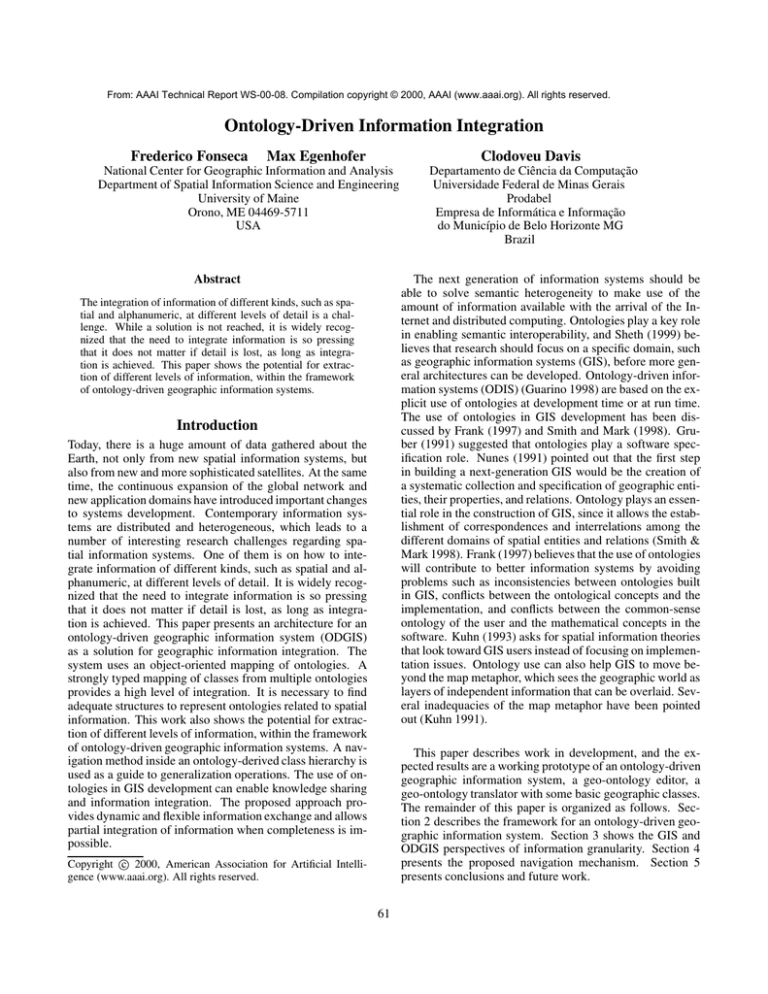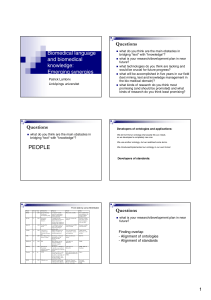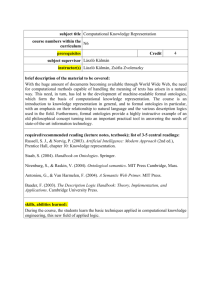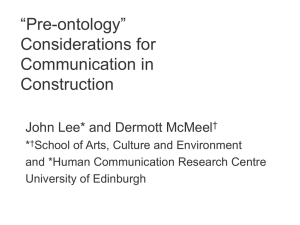
From: AAAI Technical Report WS-00-08. Compilation copyright © 2000, AAAI (www.aaai.org). All rights reserved.
Ontology-Driven Information Integration
Frederico Fonseca
Max Egenhofer
Clodoveu Davis
National Center for Geographic Information and Analysis
Department of Spatial Information Science and Engineering
University of Maine
Orono, ME 04469-5711
USA
Abstract
Departamento de Ciência da Computação
Universidade Federal de Minas Gerais
Prodabel
Empresa de Informática e Informação
do Municı́pio de Belo Horizonte MG
Brazil
The next generation of information systems should be
able to solve semantic heterogeneity to make use of the
amount of information available with the arrival of the Internet and distributed computing. Ontologies play a key role
in enabling semantic interoperability, and Sheth (1999) believes that research should focus on a specific domain, such
as geographic information systems (GIS), before more general architectures can be developed. Ontology-driven information systems (ODIS) (Guarino 1998) are based on the explicit use of ontologies at development time or at run time.
The use of ontologies in GIS development has been discussed by Frank (1997) and Smith and Mark (1998). Gruber (1991) suggested that ontologies play a software specification role. Nunes (1991) pointed out that the first step
in building a next-generation GIS would be the creation of
a systematic collection and specification of geographic entities, their properties, and relations. Ontology plays an essential role in the construction of GIS, since it allows the establishment of correspondences and interrelations among the
different domains of spatial entities and relations (Smith &
Mark 1998). Frank (1997) believes that the use of ontologies
will contribute to better information systems by avoiding
problems such as inconsistencies between ontologies built
in GIS, conflicts between the ontological concepts and the
implementation, and conflicts between the common-sense
ontology of the user and the mathematical concepts in the
software. Kuhn (1993) asks for spatial information theories
that look toward GIS users instead of focusing on implementation issues. Ontology use can also help GIS to move beyond the map metaphor, which sees the geographic world as
layers of independent information that can be overlaid. Several inadequacies of the map metaphor have been pointed
out (Kuhn 1991).
The integration of information of different kinds, such as spatial and alphanumeric, at different levels of detail is a challenge. While a solution is not reached, it is widely recognized that the need to integrate information is so pressing
that it does not matter if detail is lost, as long as integration is achieved. This paper shows the potential for extraction of different levels of information, within the framework
of ontology-driven geographic information systems.
Introduction
Today, there is a huge amount of data gathered about the
Earth, not only from new spatial information systems, but
also from new and more sophisticated satellites. At the same
time, the continuous expansion of the global network and
new application domains have introduced important changes
to systems development. Contemporary information systems are distributed and heterogeneous, which leads to a
number of interesting research challenges regarding spatial information systems. One of them is on how to integrate information of different kinds, such as spatial and alphanumeric, at different levels of detail. It is widely recognized that the need to integrate information is so pressing
that it does not matter if detail is lost, as long as integration is achieved. This paper presents an architecture for an
ontology-driven geographic information system (ODGIS)
as a solution for geographic information integration. The
system uses an object-oriented mapping of ontologies. A
strongly typed mapping of classes from multiple ontologies
provides a high level of integration. It is necessary to find
adequate structures to represent ontologies related to spatial
information. This work also shows the potential for extraction of different levels of information, within the framework
of ontology-driven geographic information systems. A navigation method inside an ontology-derived class hierarchy is
used as a guide to generalization operations. The use of ontologies in GIS development can enable knowledge sharing
and information integration. The proposed approach provides dynamic and flexible information exchange and allows
partial integration of information when completeness is impossible.
This paper describes work in development, and the expected results are a working prototype of an ontology-driven
geographic information system, a geo-ontology editor, a
geo-ontology translator with some basic geographic classes.
The remainder of this paper is organized as follows. Section 2 describes the framework for an ontology-driven geographic information system. Section 3 shows the GIS and
ODGIS perspectives of information granularity. Section 4
presents the proposed navigation mechanism. Section 5
presents conclusions and future work.
Copyright c 2000, American Association for Artificial Intelligence (www.aaai.org). All rights reserved.
61
Ontology-Driven Geographic Information
Systems
that have diverse characteristics. For instance, geographic
features usually have geometric characteristics along with
alphanumeric attributes. We propose here the use of multiple inheritance (Cardelli 1984) to define these kinds of
classes. The use of multiple inheritance allows the developer to make use of the existing ontologies to build new
classes. A geographic object should, for instance, descend
from both geometric classes and feature-oriented classes. In
the first group, all necessary representational and locational
data can be handled by inherited methods, while in the other
information on the semantics and behavior of the feature are
inherited from specific ontology-derived classes.
The use of an ontology, translated into an active information system component, leads to Ontology-Driven Information Systems (ODIS) (Guarino 1998) and, in the specific
case of GIS, it leads to what we call Ontology-Driven Geographic Information Systems (ODGIS) (Fonseca & Egenhofer 1999). ODGIS are built using software components
derived from various ontologies. These software components are classes that can be used to develop new GIS applications. Being ontology-derived, these classes embed
knowledge extracted from ontologies. The object-oriented
approach for describing the geographic world is thoroughly
discussed and established (Egenhofer & Frank 1992; Gahegan & Roberts 1988). The use of the object data model
as the basic conceptualization of space has been discussed
by Nunes (1991), where he argues that the issue of defining geographic space is actually the issue of defining and
studying the geographic objects, their attributes, and relations. Discussing the main concepts behind the objectoriented approach and its application to geo-referenced information, Worboys (1994) considers that this approach can
describe both field-based and object-based spatial models.
The ODGIS framework is presented next, focusing on the
aspects of knowledge generation and use.
The first step to build an ODGIS is to specify the ontologies using an ontology editor. The editor is able to translate the ontologies into a formal language to be used in a
computer implementation, such as Java interfaces. A Java
interface describes the set of public methods that must be
supported by a class that implements the interface, and also
their calling conventions. However, a Java interface does
not implement those methods: Each descendant class has to
provide the code for each existing interface method. Since
new classes can implement more than one interface, multiple inheritance can be achieved in Java (Gosling & McGilton
1995). These interfaces need to be complemented with Java
code by independent class developers, thus generating Java
classes.
The result from the knowledge generation phase of an
ODGIS is a set of ontologies specified in a formal language and a set of classes. The ontologies are available
to be browsed by the end user and they provide metadata
information about the available data. The result from the
translation is a set of classes that contain data and operations that constitute the system’s functionality. These classes
contain the knowledge available to be included in the new
ontology-based systems. The application developer can derive new classes, more specific to the application, called
user classes, which are different from more generic ontology
classes. User classes belong to the application ontologies
level, while ontology classes belong to top-level, domain,
or task ontologies (Guarino 1998). An application developer can build an application using either ontology classes
or user classes, although they are separated here for clarification purposes. After building ontology classes, it is important to have a mechanism that enables the application developer to create user classes. User classes represent objects
Information Granularity
The abstraction of concepts and notions about real-world objects is an important part of the creation of information systems. In the abstraction process, certain characteristics of
the objects are identified and coded in a database in such
a way that the set of characteristics is representative of the
much more complex real-world object. Depending on the
user’s interest, however, this set of characteristics can be defined to be more or less detailed.
Hornsby (1999) points out the difference between resolution and granularity. While resolution refers to the amount
of detail and representation, granularity refers to the cognitive aspects involved in selection of features. The notion of
granularity applied to GIS leads to studies of the variation
of the representation of geographic objects and phenomena
across a wide range of scales. Certain phenomena are scaledependent, i.e., their representation varies across the scales.
For instance, if an urban settlement is perceived at a small
scale, the level of detail is usually small, enough for an entire
city, with all its complex internal structure, to be represented
as a point or as a simple polygon on a map. If the same city is
perceived at a larger scale, it becomes necessary to represent
its internal structure with more detail, for instance depicting
blocks, squares, major streets, and buildings. If both representations have to coexist in a geographic database, how
could it be possible to maintain and update only the most
detailed version of the objects, and then filter out unwanted
detail to produce the less-detailed version? (Beard 1987)
Ontologies offer a possible solution to this problem, by specifying exactly how high-level abstractions relate to concepts
of a lower level by establishing methods that help to implement rules and constraints.
In the ODGIS architecture there are different levels of ontologies. Accordingly, there are also different levels of information detail. Low-level ontologies correspond to very
detailed information and high-level ontologies correspond
to more general information. Thus, if a user is browsing
high-level ontologies he or she should expect to find less
detailed information. We propose that the creation of more
detailed ontologies should be based on the high-level ontologies, so that each new ontology level incorporates the knowledge present in the higher level. These new ontologies are
more detailed, because they refine general descriptions of
the level from which they inherit. Guarino (1997) classifies
ontologies according to their dependence on a specific task
or point of view: top-level ontologies describe very general
62
The idea of a basic class, such as the Object class of
ODGIS, is suggested both in object-oriented frameworks
such as Java (Gosling & McGilton 1995) and CORBA
(OMG 1991). This idea is also present in ontology literature, where many ontologies start with a concept named
Thing. The Object class contains the basic methods used for
navigation, called Up() and Create-From(). All other functionality is implemented using roles (Pernici 1990). An object has at least a basic role and a variable number of additional ones. The method Up(), when applied to an object,
returns an object of the immediate superclass. The method
Create-From() instantiates a version of the class from an
instance of the immediate superclass. These two methods
provide the means to navigate through the whole ontology
tree. Since each class in the ontology tree is derived from
the basic class, each interface inherits the necessary navigation tools. An object has to adapt itself to various views
and relationships through changes of classes, usually from
a more detailed to a less detailed class. For instance, if a
polygonal object is asked to merge with another polygonal
object in its superclass, this object has to adapt itself by generating an instance of the superclass. Data are never lost in
conversions, because they never occur in the original object,
but only in its copies or instances.
concepts, domain ontologies describe the vocabulary related
to a generic domain, task ontologies describe a task or activity, and application ontologies describe concepts depending on both a particular domain and a task, and are usually a
specialization of them. Our solution allows the user to incrementally go from coarse to fine-grained ontologies on-line,
eliminating thus the division between on-line and off-line
ontologies presented in (Guarino 1997).
Objects and Navigation
In ODGIS, ontologies are translated into classes. All classes
derive from an initial class, called Object. This class has special operations for navigation in the ontology tree. The combined use of objects and ontologies provides a rich model to
represent geographic entities, avoiding the problems of poor
representation (Nunes 1991). In this section we describe the
basic structure of an object in ODGIS and the mechanism
for navigation.
In general, user classes have to inherit from more than one
ontology class, therefore the ability to implement multiple
inheritance is necessary to build new classes from various
ontologies. Multiple inheritance is a controversial concept,
with benefits and drawbacks (Tempero & Biddle 1998) and
we decided to use it because we believe that it is the best
way to represent such complex features as geographic objects. As an example, consider a class that is used to represent land parcels. This class needs to include information on
the geometric shape of the parcel, as well as associated information about ownership, land use limitations, and so on.
The geographic parcel class should descend from both a Parcel class and a Polygon class. Therefore, instead of having
a single class that contains its own geometry and the methods necessary to handle it, there is a class that inherits such
geometric characteristics and methods from a more generic
Polygon class, and inherits application-specific characteristics and methods from a more generic Parcel class. This
approach allows methods that deal with the geometry of the
representations to have direct access to the geometry of the
parcel, instead of relying on the Parcel class to handle its
geometry to other class for appropriate treatment. This solution is achieved through interface conformance. A class
should conform to every parent class, so the parcel of the
example can be seen and treated as both an instance of Polygon and an instance of Parcel.
The usual alternative for the multiple inheritance mechanism is to define the Parcel class as a descendant of the
Polygon class. This succeeds in giving the Parcel class direct access to both its geometry and its application-specific
characteristics, but makes it harder to implement different
representations for the parcel, as demanded by other users
or applications. For instance, another application might represent parcels using symbols or the parcel’s front line. The
proposed mechanism avoids this problem, and allows the existence of multiple representations for the same class, each
of them adequate for a range of scales or a specific use. In
many cases, the most detailed representation can be considered a primary representation, and the alternative representations can be obtained from it, using a set of transformation
operators (Davis & Laender 1999).
Conclusions
We presented a solution for geographic information integration inside a framework of ontology-driven geographic information systems. The solution allows for different levels
of information sharing using a navigation system inside a
hierarchy of classes derived from ontologies. We presented
a navigation system in which objects can generate new instances with different levels of information detail, and proposed the use of a special parent class that allows navigation
from application ontologies to top-level ontologies, passing
through domain and task ontologies. This navigation capability shortens the gap between generic and specialized
ontologies, enabling the sharing of software components
and information. ODGIS employs user classes that are derived through multiple inheritance from various ontologies
to solve the problem of semantic heterogeneity (Bishr 1997).
We also presented here how ontology-driven geographic information systems can deal with different levels of information. The solution presented here tries to shorten the gap between coarse and fine-grained ontologies in ontology-driven
information systems (Guarino 1997) by allowing navigation
through ontologies of all specialization levels.
Acknowledgments
This work was partially supported by the National Science
Foundation under NSF grant numbers SBR-9700465 and
IIS-9970123, NASA/EPSCoR fellowship grant number 9958 and an ESRI graduate fellowship. Max Egenhofer’s
research is further supported by NSF grants IRI-9613646,
BDI-9723873, and EIA-9876707; by the National Imagery
and Mapping Agency under grant number NMA202-97-11023; by the National Institute of Environmental Health Sciences, NIH, under grant number 1 R 01 ES09816-01 and by
63
a contract with Lockheed Martin. c 2000
Symposium on Computer-Assisted Cartography, volume 6,
261–274.
Kuhn, W. 1993. Metaphors create theories for users. In
Frank, A., and Campari, I., eds., Spatial Information Theory, volume 716 of Lectures Notes in Computer Science.
Berlin: Springer-Verlag. 366–376.
Nunes, J. 1991. Geographic space as a set of concrete geographical entities. In Mark, D., and Frank, A., eds., Cognitive and Linguistic Aspects of Geographic Space. Norwell,
MA: Kluwer Academic Publishers. 9–33.
OMG., ed. 1991. The Common Object Request Broker: Architecture and Specification, Revision1.1. OMG Document
No. 91.12.1.
Pernici, B. 1990. Objects with roles. In IEEE/ACM Conference on Office Information Systems, 205–215.
Sheth, A. 1999. Changing focus on interoperability in
information systems. In Goodchild, M.; Egenhofer, M.;
Fegeas, R.; and Kottman, C., eds., Interoperating Geographic Information Systems. Norwell, MA: Kluwer Academic Publishers. 165–180.
Smith, B., and Mark, D. 1998. Ontology and geographic
kinds. In International Symposium on Spatial Data Handling, 308–320.
Tempero, E., and Biddle, R. 1998. Simulating multiple
inheritance in Java. Technical Report CS-TR-98/1, Victoria University of Wellington, School of Mathematical and
Computing Sciences.
Worboys, M. 1994. Object-oriented approaches to georeferenced information. International Journal of Geographical Information Systems 8(4):385–399.
References
Beard, K. 1987. How to survive a single detailed database.
In Chrisman, N., ed., AUTO-CARTO 8, Eighth International Symposium on Computer-Assisted Cartography,
211–220.
Bishr, Y. 1997. Semantic Aspect of Interoperable GIS.
Ph.D. Dissertation, Wageningen Agricultural University.
Cardelli, L. 1984. A semantics of multiple inheritance. In
Kahn, G.; McQueen, D.; and Plotkin, G., eds., Semantics
of Data Types, volume 173 of Lecture Notes in Computer
Science. New York: Springer-Verlag. 51–67.
Davis, C., and Laender, A. 1999. Multiple representations
in GIS: Materialization through map generalization, geometric and spatial analysis operations. In Medeiros, C. B.,
ed., 7th ACM Symposium on Advances in Geographic Information Systems, 60–65. Kansas City, MO: ACM Press,
N.Y.
Egenhofer, M., and Frank, A. 1992. Object-oriented modeling for GIS. Journal of the Urban and Regional Information Systems Association 4(2):3–19.
Fonseca, F., and Egenhofer, M. 1999. Ontology-driven geographic information systems. In Medeiros, C. B., ed., 7th
ACM Symposium on Advances in Geographic Information
Systems, 14–19. Kansas City, MO: ACM Press, N.Y.
Frank, A. 1997. Spatial ontology: A geographical point of
view. In Stock, O., ed., Spatial and Temporal Reasoning.
Dordrecht, The Netherlands: Kluwer Academic Publishers. 135–153.
Gahegan, M., and Roberts, S. 1988. An intelligent, objectoriented geographical information system. International
Journal Geographical Information Systems, Vol. 2:101–
110. In Surveying Engineering Library.
Gosling, J., and McGilton, H. 1995. The Java language environment: a white paper. Technical report, Sun Microsystems.
Gruber, T. 1991. The role of common ontology in achieving sharable, reusable knowledge bases. In Principles
of Knowledge Representation and Reasoning, 601–602.
Cambridge, MA: Morgan Kaufmann.
Guarino, N. 1997. Semantic matching: Formal ontological
distinctions for information organization, extraction, and
integration. In Pazienza, M., ed., Information Extraction:
A Multidisciplinary Approach to an Emerging Information
Technology, International Summer School, SCIE-97, volume 1299 of Lecture Notes in Computer Science, 139–170.
Guarino, N. 1998. Formal ontology and information systems. In Guarino, N., ed., Formal Ontology in Information
Systems. Amsterdam, Netherlands: IOS Press. 3–15.
Hornsby, K. 1999. Identity-Based Reasoning about
Spatio-Temporal Change. Ph.D. Dissertation, University
of Maine.
Kuhn, W. 1991. Are displays maps or views? In Mark, D.,
and White, D., eds., AUTO-CARTO 10, Tenth International
64





